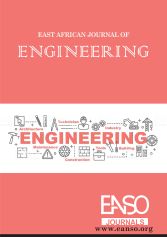Forecasting Maximum Temperature Using Comparable Optimizers in LSTM Deep Learning Model: A Case of Koga Mango Farm, Mkuranga District, Tanzania
الملخص
Mango farming is an important economic activity in Tanzania, contributing to the economy through exports of mango fruits and products and acting as a primary source of income for many farmers. Maximum temperature is one of the critical weather variables affecting the growth of mango, having an impact both on flowering stages and fruits, so failure to correctly forecast extreme maximum temperature and take appropriate measures may pose challenges such as poor quality of mango fruits and hence low income to farmers. Long Short-Term Memory (LSTM) is one of the famous deep learning models used for forecasting time-series variables such as temperature. In the LSTM model, an optimizer is a very important component as it is used to minimize loss during model training. Despite there being a number of optimizers, which can be used in the LSTM model, there is still a research gap, on which one is the best-performing optimizer in forecasting tasks, especially in the context of forecasting maximum temperature in Koga farm, a mango farm located in Mkuranga district, Pwani region, Tanzania which has unique climatic conditions and has a small geographical area. This study aims to fill this gap by comparing the performances of common LSTM optimizers and developing an LSTM model for helping Koga farm officials forecast daily maximum temperature using the best-performing optimizer. The experimental findings reveal that Adam and Adamax are the two best-performing optimizers with both having Root Mean Squared (RMSE) values of 0.089 on the test set (unseen data). The performance of the remaining optimizers on the test set with their RMSE values in brackets are as follows; RMSprop (0.091), Adagrad (0.099), SGD (0.102) and Adadelta (0.107). This study recommends that software developers and researchers use either Adam or Adamax optimizer in LSTM models when forecasting temperature in environments which resemble that of the Koga farm in Tanzania.
التنزيلات
المراجع
William, J., Hella, J., Lars, E., Offenberg, J., Mwatawala, M. & Rwegasira, G. (2015). Partial budgeting analysis of different strategies for management of insect pests in cashew and mango orchards in Tanzania. International Journal of Sustainable Agricultural Research, 2(4), 98-110
Baltazari A., Hosea M., Lucy C., Theodosy M., Abdul K., George T., Jaspa S., Gopinadhan P., Alan S., Jayasankar S. & Maulid M. (2020). Evaluation of post-harvest losses and shelf life of fresh mango (Mangifera indica L.) in Eastern zone of Tanzania. International Journal of Fruit Science, 20(4), 855-870
World Bank (2022). Tanzania Guavas, mangoes and mangosteens, fresh or dried exports by country in 2022. Retrieved January 31, 2025, from https://wits.worldbank.org/trade/comtrade/en/country/TZA/year/2022/tradeflow/Exports/partner/ALL/product/080450
Food and Agriculture Organization of the United Nations. (2023). Countries by Commodity Rankings. Retrieved January 31, 2025, from https://www.fao.org/faostat/en/#rankings/countries_by_commodity
Rajan, S. (2012). Phenological responses to temperature and rainfall: A case study of mango. Tropical fruit tree species and climate change, 71
Khalifa, S., & Abobatta, W. (2023). Climate Changes and Mango Production (Temperature). IgMin Research, 1(1), 043-046
Li, Y., Tongfei L., Wei L., Zhiyao L., & Junxian W. (2023). Prediction of Daily Temperature Based on the Robust Machine Learning Algorithms. Sustainability 15(12), 9289
Sowmya B., Nikhil C., Seema S., & Srinivasa, K. (2020). Fake News Detection using LSTM Neural Network Augmented with SGD Classifier. Solid State Technology, 63, 6
John-Africa, E. & Emmah, V. (2022). Performance Evaluation of LSTM and RNN Models in the Detection of Email Spam Messages. European Journal of Information Technologies and Computer Science, 2(6), 24-30
Anh, D., Thanh, D., Le, H., Sy, B., Tanim, A., Pham, Q., Dang, T., Mai, S., & Dang, N. (2023). Effect of gradient descent optimizers and dropout technique on deep learning LSTM performance in rainfall-runoff modeling. Water Resources Management, 37(2), 639-657
Karabıyık, M. (2023). A Framework for Parametric Model Selection in Time Series Problems. Gazi Mühendislik Bilimleri Dergisi, 9(4), 82-91
Afan, H., Atheer A., Basheer A., Faidhalrahman K., Alaa A., Md Munir K., Muhammad, M., & Ammar K. (2024). LSTM Model Integrated Remote Sensing Data for Drought Prediction: A Study on Climate Change Impacts on Water Availability in the Arid Region. Water, 16, 19, 2799
Teixeira, R., Adelaide C., Eduardo, P., & José Baptista. (2024). Enhancing Weather Forecasting Integrating LSTM and GA. Applied Sciences 14, 13, 5769.
Chai, Q., Shuting, Z., Qingqing, T., Chaoqiang, Y., & Lei, G. (2024). Daily Runoff Prediction Based on FA-LSTM Model, Water 16,16, 2216
Waqas, M., Usa H., Phyo, H., & Shakeel, A. (2024). Seasonal WaveNet-LSTM: A Deep Learning Framework for Precipitation Forecasting with Integrated Large Scale Climate Drivers. Water 16, 22, 3194
Yan, Y., Gan, L., Qingliang, L., & Jinlong, Z. (2024). Enhancing Hydrological Variable Prediction through Multitask LSTM Models. Water 16, 15, 2156
Majule, A. (2012). Implications of ecological and social characteristics to community livelihoods in the coastal areas of Tanzania. African Journal of Environmental Science and Technology, 6(1), 72-79
Tamiminia, H., Salehi, B., Mahdianpari, M., Quackenbush, L., Adeli, S. & Brisco, B. (2020). Google Earth Engine for geo-big data applications: A meta-analysis and systematic review. ISPRS journal of photogrammetry and remote sensing, 164, 152-170
Huntington, J., Hegewisch, K., Daudert, B., Morton, C., Abatzoglou, J., McEvoy, D. & Erickson, T. (2017). Climate engine: Cloud computing and visualization of climate and remote sensing data for advanced natural resource monitoring and process understanding. Bulletin of the American Meteorological Society, 98(11), 2397-2410
Hochreiter, S. & Schmidhuber, J. (1997). Long short-term memory. Neural Comput.,9, 1735–1780
Bisong, E. (2019). Google colaboratory. In Building machine learning and deep learning models on Google Cloud Platform: a comprehensive guide for beginners. Berkeley, CA: Apress.
Bakhashwain, N. & Sagheer, A. (2021). Online Tuning of Hyperparameters in Deep LSTM for Time Series Applications. International Journal of Intelligent Engineering & Systems, 14(1)
الحقوق الفكرية (c) 2025 Isakwisa Gaddy Tende, Mbazingwa Elirehema Mkiramweni

هذا العمل مرخص حسب الرخصة Creative Commons Attribution 4.0 International License.




























